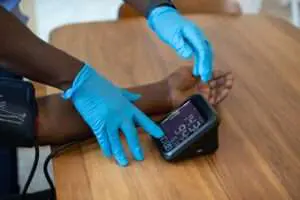
Welcome back to the Blue Goat Cyber blog, your trusty guide in the ever-evolving world of cybersecurity. Today, we’re zeroing in on a topic gaining momentum faster than a hacker on a mission: securing IoT devices in healthcare. Why? Because as these devices become integral to our healthcare system, they also emerge as potential gateways for cyber threats, directly impacting patient safety.
The Surge of IoT in Healthcare: A Double-Edged Sword
Imagine a hospital where everything is interconnected. Your heart monitor feeds real-time data to a central system. Your medication dispenser alerts staff when it’s time for the next dose. This isn’t sci-fi; it’s the reality of modern healthcare, courtesy of the Internet of Things (IoT).
However, while revolutionary, this interconnectivity brings its own challenges. Each device is a potential entry point for cyberattacks. A compromised device can mean anything from stolen patient data to life-threatening malfunctions.
The Risks: Understanding What’s at Stake
Let’s paint a picture of the risks. In 2017, the WannaCry ransomware attack caused chaos in hospitals across the UK. Non-functional devices led to canceled surgeries and patient care disruptions. This incident wasn’t just a wake-up call but a blaring alarm.
The risks are multifaceted:
- Data Breach: Patient data is gold for cybercriminals. A breach can lead to identity theft and serious privacy violations.
- Device Tampering: Hackers could alter medical devices’ functioning, leading to incorrect treatments or diagnoses.
- Network Takeover: Compromised devices can be used as a springboard to attack the broader hospital network.
Proactive Measures: The Art of Defense
So, how do we fortify these devices? Here’s where Blue Goat Cyber brings you some practical, actionable tips:
- Regular Software Updates: This one’s a no-brainer but often overlooked. Regular updates patch security vulnerabilities, keeping devices a step ahead of hackers.
- Strong Authentication Protocols: Implement robust authentication mechanisms. Think beyond simple passwords – we’re talking biometrics and two-factor authentication.
- Network Segmentation: Isolate medical devices on a separate network. If one device is compromised, it won’t give hackers free rein over the entire system.
- Vigilant Monitoring: Employ continuous monitoring for suspicious activities. Quick detection equals quick response.
- Employee Education: Train healthcare staff on basic cybersecurity hygiene. Awareness can be the first line of defense.
Collaboration is Key: The Role of Manufacturers and Healthcare Providers
Securing IoT devices isn’t a solo mission. It requires a tag-team approach. Manufacturers must prioritize security in the design phase, embedding robust security features. Meanwhile, healthcare providers should diligently choose secure devices and maintain them properly.
The Future: A Blend of Innovation and Security
The future of IoT in healthcare is bright, but only if we navigate it with security as a guiding star. Advances like AI and machine learning can play a significant role in predicting and preventing attacks.
In conclusion, securing IoT devices in healthcare isn’t just about protecting data; it’s about safeguarding human lives. As we embrace these technological marvels, let’s not forget the responsibility that comes with them. Stay tuned to Blue Goat Cyber for more insights into the world of cybersecurity, where we make the complex simple and the risky secure. Stay safe out there!
Contact us for help with medical device security.


